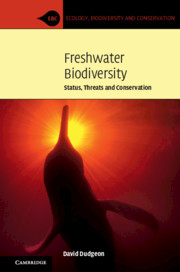Book contents
- Freshwater Biodiversity
- Ecology, Biodiversity and Conservation
- Freshwater Biodiversity
- Copyright page
- Epigraph
- Contents
- Foreword
- Permissions for Epigraphs
- 1 The Freshwater Commons
- 2 Global Endangerment of Freshwater Biodiversity
- 3 Overexploitation
- 4 Alien Species and Their Effects
- 5 River Regulation
- 6 Vanishing Lakes and Threats to Lacustrine Biodiversity
- 7 How Will Climate Change Affect Freshwater Biodiversity?
- 8 Ecosystem Services and Incentivizing Conservation of Freshwater Biodiversity
- 9 Conservation of Freshwater Biodiversity
- Afterword
- References
- Species Index
- General Index
- Plate Section (PDF Only)
Afterword
Published online by Cambridge University Press: 16 June 2020
- Freshwater Biodiversity
- Ecology, Biodiversity and Conservation
- Freshwater Biodiversity
- Copyright page
- Epigraph
- Contents
- Foreword
- Permissions for Epigraphs
- 1 The Freshwater Commons
- 2 Global Endangerment of Freshwater Biodiversity
- 3 Overexploitation
- 4 Alien Species and Their Effects
- 5 River Regulation
- 6 Vanishing Lakes and Threats to Lacustrine Biodiversity
- 7 How Will Climate Change Affect Freshwater Biodiversity?
- 8 Ecosystem Services and Incentivizing Conservation of Freshwater Biodiversity
- 9 Conservation of Freshwater Biodiversity
- Afterword
- References
- Species Index
- General Index
- Plate Section (PDF Only)
Summary
Fresh waters are not amenable to protection by fortress conservation, since entire drainage basins can seldom be set aside. Site selection by conservation modelling has shortcomings because of the directional connectivity of river ecosystems. In the many cases where habitat degradation is the primary threat to freshwater biodiversity, restoration measures (that include riparia) may ameliorate matters, allowing species persistence or even recovery. However, rehabilitation is often the best that can be achieved.Mitigation of the barrier effects of dams by fishways have limited effectiveness, but complete removal of dams is an effective means of restoring connectivity.Ex situ (captive breeding, reintroduction, translocation) and in situ conservation measures – sometimes in combination – have been applied to a variety of freshwater animals, using new techniques such as eDNA for monitoring. Various international networks have been established recently to facilitate collaboration on conservation and improve data collection and sharing. There are thus reasons to be hopeful – rather than optimistic – about the prospects for preserving freshwater biodiversity in a warming world.
Keywords
- Type
- Chapter
- Information
- Freshwater BiodiversityStatus, Threats and Conservation, pp. 399 - 404Publisher: Cambridge University PressPrint publication year: 2020



